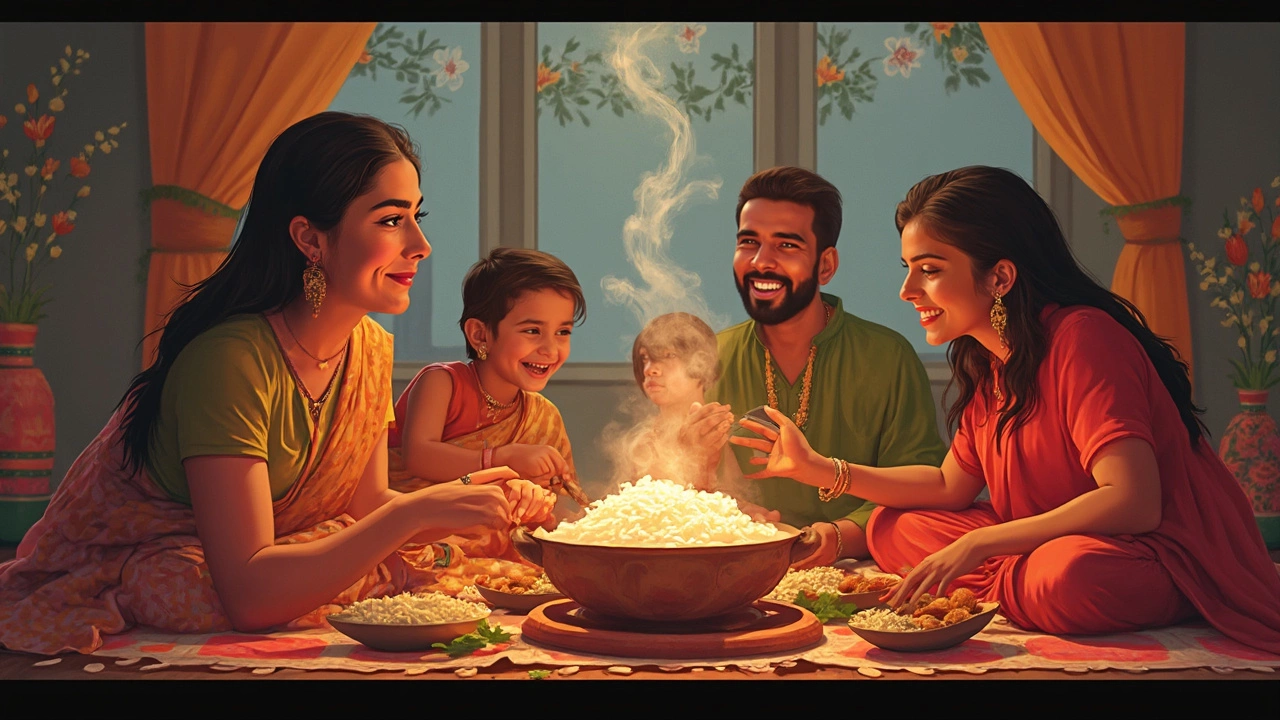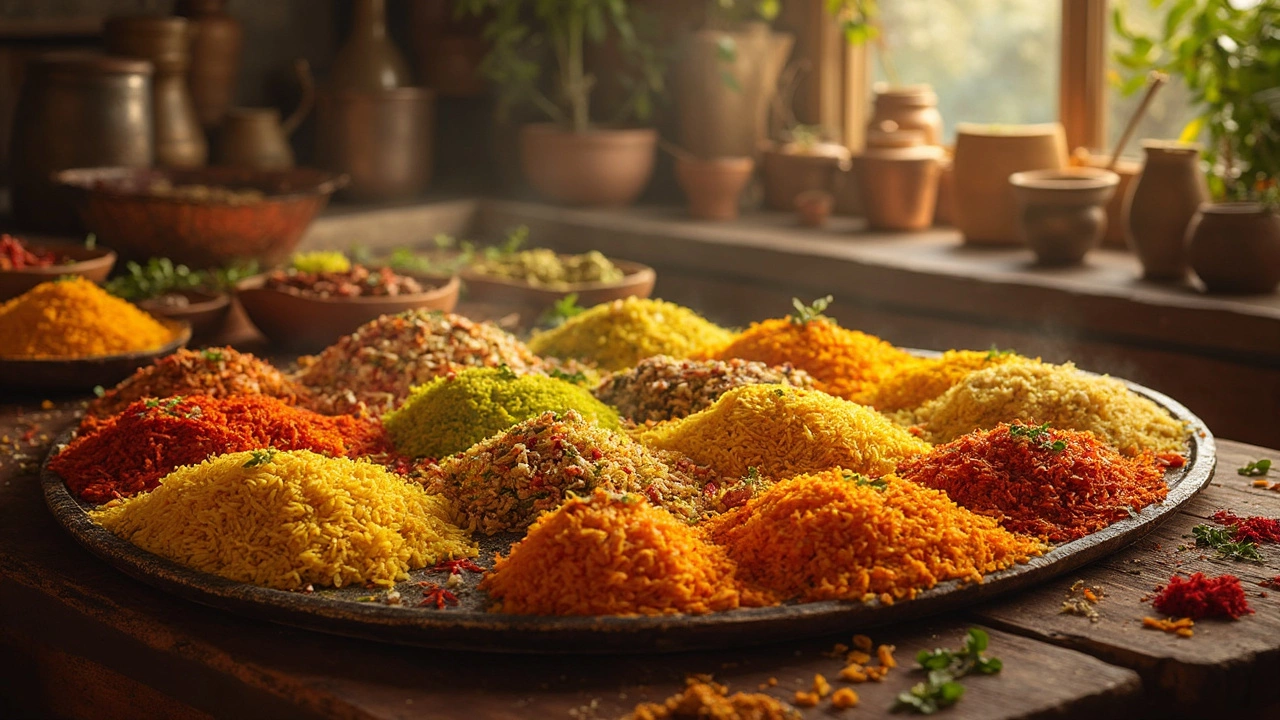15 Apr 2025
- 0 Comments
Ever wondered what most people in India eat every day? Well, it’s rice. This humble grain is a big deal in many Indian homes. It's not just about filling tummies; it’s about tradition, culture, and taste all rolled into one.
Now, why rice, you might ask? It's versatile, easy to cook, and oh, the recipes are endless! From biryanis to simply boiled rice paired with dal (lentil soup), it’s all about simplicity meeting deliciousness. And here’s a fun fact: there are hundreds of rice varieties in India, each with its unique flavor and texture.
Cooking rice might sound easy, but getting it just right can be tricky. So, knowing a few tips can really up your game in the kitchen. Imagine the aroma of steaming basmati rice drifting through your home. Sounds inviting, doesn’t it? Keep reading to discover some amazing ways to enjoy this staple.
- The Ubiquitous Staple: Rice
- Rice in Indian Culture
- Versatile Rice Dishes
- Simple Rice Recipes to Try
- Nutritional Value of Rice
- Tips for Perfect Rice Cooking
The Ubiquitous Staple: Rice
If there's one food that truly stands out in Indian cuisine, it's rice. This staple is a cornerstone of meals across the country. Whether in the bustling streets of Mumbai or serene villages in Kerala, rice is cherished for its flavor and versatility.
Rice is more than just food in India; it's woven into the country's social fabric. It's often said, 'Rice is life.' And that's not just a saying. From weddings to festivals, it's part of every celebration. Different regions have their unique rice varieties and dishes, making it a remarkable journey for anyone exploring Indian cuisine.
Take Basmati, for instance, known for its aroma and long grains. It's the star of many Indian food festivities, especially in beloved biryanis. Then there's Sona Masoori, common in everyday meals in the southern parts. It's light and aromatic, perfect for those comforting lunch bowls.
Besides its cultural significance, rice is immensely adaptable, taking on the flavors of whatever it's cooked with. This makes it a perfect canvas for those learning to cook easy Indian recipes. A bit of experimenting with spices can turn a plain bowl of rice into a delightful masterpiece.
If you're curious about consumption, check this out: On average, an Indian eats over 50 kg of rice per year! That's a lot of Indian food goodness being savored across the nation.
- Basmati Rice: Ideal for biryanis and pilafs.
- Jasmine Rice: Perfect for light, fragrant dishes.
- Brown Rice: A healthier alternative packed with nutrients.
This love for rice isn't just limited to India. Its influence spreads, as many international dishes now feature Indian-style rice, bringing a bit of that aromatic magic to kitchens worldwide.
Rice in Indian Culture
Rice in India isn't just food; it's a whole cultural affair. Imagine this: it's part of rituals, celebrations, and even daily life. It's like that friend who's always there for you, rain or shine. From north to south, east to west, you'll find rice in many shapes and forms on Indian tables.
In many Indian states, rice isn't just for eating—it's a symbol of prosperity and fertility. You might see it used in wedding ceremonies where it's often showered on the couple as a blessing. It's also a big part of festivals like Pongal in Tamil Nadu or Onam in Kerala, where multiple rice dishes are the stars of the show.
Each region has its unique way of making Indian food more exciting with rice. For example, in South India, a meal isn’t complete without rice-based dosa or idli for breakfast. In Bengal, biryani is like the crown jewel of celebrations. And then there's the famous 'kheer,' a delicious dessert made from rice and milk, enjoyed across the country.
Even with changing food trends, rice remains a constant in Indian cuisine. It's affordable, plentiful, and provides a comforting base for lots of spicy, flavorful dishes. So, if you are looking to whip up something traditional, easy Indian recipes with rice are your go-to. It’s super adaptable, making it easy to impress your family or friends with just a few ingredients!
| State | Popular Rice Dish |
|---|---|
| Tamil Nadu | Curd Rice |
| West Bengal | Macher Jhol (Fish Curry) with Rice |
| Punjab | Chole Chawal |
| Kerala | Thalassery Biryani |
Versatile Rice Dishes
Rice in India isn't just a side dish—it's often the star of the meal. With flavors ranging from mild to spicy, there's a rice dish for every taste. You'll find that Indian cuisine celebrates diversity, and rice dishes are a perfect example.
Let's talk about biryani, a fan favorite! This dish is packed with spices and usually includes meat or vegetables. It's a meal on its own and is perfect for festive occasions. What makes it special is the way the rice absorbs all those aromatic spices and flavors.
If you like something a bit simpler, khichdi is your friend. It's a comforting mix of rice and lentils, and every Indian household has its unique recipe. It's the go-to dish when someone needs a warm, soothing meal.
Then, there's pulao, which is basically rice cooked with veggies or meat, flavored with subtle spices. It's quick, easy, and perfect for a weekday meal when you’re short on time but craving something fulfilling.
Let's not forget that Indian cuisine is not shy about sweet treats either! Rice pudding, known as 'kheer,' is a creamy dessert that's incredibly popular, especially during festivals and celebrations.
With such a variety, learning to cook these dishes can bring the essence of Indian food into your home, adding flavor and excitement to your meals.

Simple Rice Recipes to Try
Looking to spice up your meal routine with something easy yet scrumptious? Let's dive into some easy Indian recipes that put rice in the spotlight, keeping it simple but super tasty.
First off, let's talk about Lemon Rice. It's one of those dishes that's bright, zesty, and ridiculously easy to whip up. All you need is some cooked rice, a squeeze of lemon, and a handful of spices. Here’s a quick rundown:
- Heat oil in a pan and add mustard seeds. Let them crackle.
- Add some turmeric powder, peanuts, and curry leaves. Sauté until the peanuts are golden.
- Mix in the cooked rice and lemon juice. Stir well and season with salt.
- Garnish with coriander leaves for that fresh touch.
Next on the list is Veg Pulav. It's a colorful mix of rice and veggies, and you can make it all in one pot. Here's how to do it:
- In a saucepan, heat some oil and sauté onion, ginger, and garlic.
- Add chopped veggies like carrots, peas, and beans. Sauté for a few minutes.
- Mix in rinsed rice and water, season with salt, and cover to cook until rice is done.
- A touch of garam masala at the end gives it a warm, spicy kick.
These recipes are not just delightful but also perfect for those looking to explore Indian cuisine without spending hours in the kitchen. You're bound to impress your family with these simple rice recipes.
Nutritional Value of Rice
Rice might seem unassuming, but it's packed with the good stuff we need to function every day. This staple grain is high in carbohydrates, giving us the energy to tackle our busy lives. Particularly, white and brown rice are common in India, and each has its unique benefits.
Brown rice is a bit like the cool, health-conscious cousin of white rice. It retains more nutrients because it's less processed. That means more fiber, more vitamins, and more minerals. But, white rice isn't all bad. It's usually enriched with iron and B vitamins like folic acid, making it a great option for some nutrients.
According to Julia Reedy, a well-known nutritionist, "Rice is a great foundation for balanced meals. Pairing rice with a variety of vegetables and proteins can make it nutritionally satisfying."
Check out this simple table to compare the nutritional punch of 100 grams of cooked white and brown rice:
| Nutrient | White Rice | Brown Rice |
|---|---|---|
| Calories | 130 | 112 |
| Carbohydrates | 28g | 23g |
| Protein | 2.4g | 2.5g |
| Fiber | 0.4g | 1.8g |
So, whether you're opting for white or brown, rice is reliable and versatile. Just keep balance in mind—mix it with veggies, legumes, or lean meats to up the nutritional value of your plate. It’s like making your meals work harder for you!
Tips for Perfect Rice Cooking
Nailing that bowl of perfectly cooked rice is easier than you think. Let's dig into some nifty tips to amp up your rice-cooking game.
First off, always rinse your rice. This simple step makes a big difference by getting rid of excess starch that'll make your rice sticky. Run it under cold water until the water runs clear.
The water-to-rice ratio is crucial. The general guideline is to use about two cups of water for every cup of rice, but this can vary depending on the type of rice. Check the package instructions if you're unsure.
Here’s a quick checklist to help you out:
- Boil, then Simmer: Bring your water to a boil before adding the rice, and then reduce to a simmer.
- Keep It Covered: Use a tight-fitting lid to trap steam. Lifting the lid lets steam escape, which affects cooking.
- Rest It: Once cooked, remove from heat and let it sit covered for about 10 minutes. This helps the grains set and prevents clumping.
- Fluff It Up: Use a fork to fluff your rice before serving. It's the secret to getting those nice, separate grains.
These tips work wonders for any type of rice dish, whether you’re whipping up a fancy biryani or just craving some simple, steamed rice. Remember, practice makes perfect, so don't hesitate to experiment with these pointers the next time you're in the kitchen!
Here's a quick glance at typical water ratios for different types of rice:
| Rice Type | Water Ratio |
|---|---|
| Basmati | 1:1.5 |
| Jasmine | 1:1.75 |
| Brown Rice | 1:2.5 |
Paying attention to these small details ensures your efforts with Indian food will be nothing short of amazing. So, go ahead and get that pot boiling!
